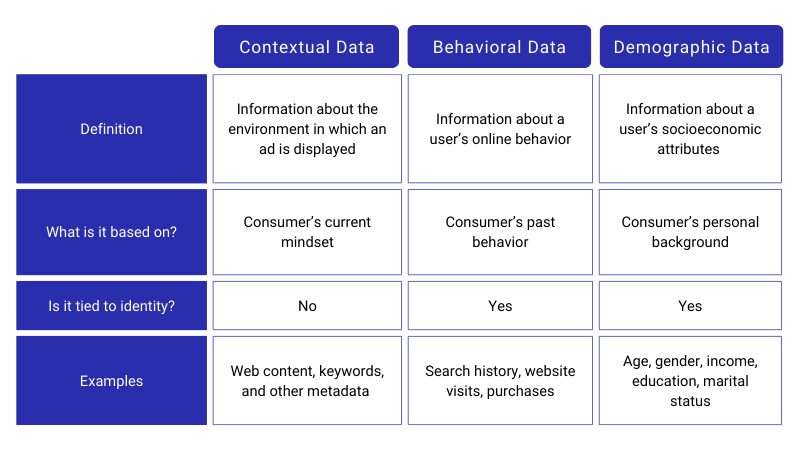
All ads aspire to deliver the “right message to the right person at the right moment.” Some ads set out to burnish brand awareness and affinity; others aim to inspire a purchase. The primary role of contextual data in advertising is to identify an environment where mindset, content, and commerce reflect and inform each other seamlessly.
What is Contextual Data?
Contextual data consists of the details and insights that provide perspective into an event, person, or thing. Greater than the sum of its parts, it ties disparate facts to create a clearer image of a consumer’s interests and mindset when interacting with particular content and the spaces around it.
See how contextual data stacks up against other common data types below:

How Does Contextual Data Work?
Contextual data allows marketers to place ads where and when they will be most effective. Think of contextual data points as the pieces of a jigsaw puzzle. Each piece represents instructions that promote the assembly of a complete picture.
That finished puzzle, a marketer’s ad targeting strategy, shows the beauty of “consumer moments” —those critical times in a buyer’s journey when they’re poised for action. In other words, ‘the stars align’.”
It’s important to note that these moments are fleeting. The puzzle is disassembled, and a new one is created in a matter of seconds — allowing other advertisers to step in with relevant offers when the stars align for their brand.
Contextual Data in Action
Let’s look at a real-word example of contextual marketing. It wouldn’t make much sense for a jet ski brand to blast out an email in search of interested consumers. For a considered purchase of this size, contextual data can help marketers reach consumers at critical moments along their path to purchase.
In typical online advertising, geodata and real-time weather information could inform a targeted placement. But with contextual data, brands can go a step further, considering the prospect’s mindset at the exact moment they will see an ad.
For example, a consumer who is reviewing Airbnb listings for lake homes is likely planning a vacation. At that specific moment, they are more inclined to be receptive to an ad for a jet ski. This same person might not be as open to a big ticket water-related purchase an hour or two later when they’re thinking about that evening’s dinner plans.
Contextual data knows timing and interest are the necessary elements that can make a difference in an ad’s ultimate effectiveness.
Benefits of Contextual Data
Identifying audiences who are likely interested in a marketer’s message rather than apt to be annoyed is a win for advertisers, publishers, and consumers alike. Contextual data allows brands to target their ads in curated environments where audiences are primed to engage.
1. Privacy-Friendly
Unlike behavioral data, this brand of data isn’t reliant on personal user information. It aligns ads with consumed content, not the individual’s personal data. This makes it more important than ever in the face of cookie depreciation.
2. Relevant
Delivering relevant offers based on the surrounding context enhances the user experience and puts the consumer in a more open position to the advertiser. For example, delivering ads for sports equipment alongside a sports news article simply makes sense.
3. Brand-Safe
By aligning ads with content that is congruent with the brand’s values and message, contextual targeting naturally ensures brand safety. It avoids placing ads in inappropriate or harmful contexts, which is a risk with automated or behavioral targeting.
4. Non-Intrusive
With contextual ad placements, users don’t get the feeling they’re being “followed” across different sites that have nothing to do with the ad being served. That alone can improve consumers’ perception of both the ad and the brand it represents.
Contextual Data & the Rise of Commerce Media
The past five years have seen the rise of commerce media and retail media networks. In part, the growth of those two strategic advertising tools reflects ecommerce retailers’ greater understanding of the value of their first-party customer data.
Within the scope of those origins, it’s important to recognize that contextual data has played a leading role in the growth of commerce media. According to Fluent EVP & GM, Brian Hogan’s recent piece for AdExchanger, “While audience data can be helpful for auxiliary concerns like verification and frequency capping, it’s contextual ad triggers that are poised to become far more useful and reliable in the age of commerce media.”
Hogan notes that this type of data has an additional appeal to publishers and retailers alike. Given that both sides of the ad equation operate on razor-thin margins and increasingly need to offer a substantial level of proof that an ad placement drove an outcome, contextual data offers a greater degree of clarity.
If content is king, then contextual data is what keeps it on the throne. It achieves that goal by delivering meaningful advertising to consumers, publishers, and marketers.
Learn how Fluent is leveraging contextual cues to help advertisers deliver relevant offers in the post-purchase moment here.